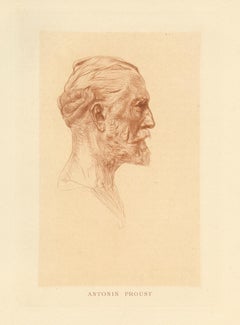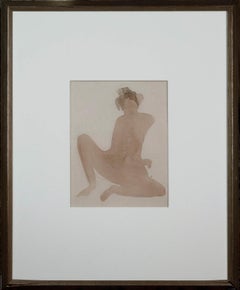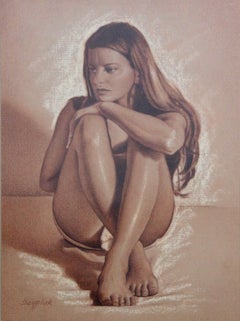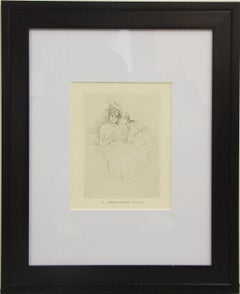Auguste Rodin Art
to
2
1
1
3
2
1
Overall Height
to
Overall Width
to
1
1
3
6
2
1
1
10
314
140
127
119
2
1
1
1
1
Period: 19th Century
Artist: Auguste Rodin
"Antonin Proust" original drypoint
By Auguste Rodin
Located in Henderson, NV
Medium: original etching and drypoint. Catalogue reference: Delteil 10. Published in Paris in 1899 by H. Floury for Auguste Rodin "Statuaire" by Lon Maillard. This impression is prin...
Category
1890s Auguste Rodin Art
Materials
Drypoint, Etching
Dante & Virgilus - Etching, (Ed. Goupil, 1897)
By Auguste Rodin
Located in Paris, FR
ARTISTE: after Auguste RODIN
TITLE : Dante & Virgilus
MEDIUM : Etching/photogravure after the original drawing
SIGNATURE : Unsigned
YEAR : 1897
PAPER : Vellum
SIZE : 13 x 10"
INFOR...
Category
1890s Academic Auguste Rodin Art
Materials
Etching
Rare Rodin Watercolour & Pencil on Paper of a Seated Nude - The Cambodian Dancer
By Auguste Rodin
Located in London, GB
Auguste RODIN (1840-1917)
Seated Nude, Cambodian Dancer
c. 1898 - 1900
Pencil and watercolour
11.5 x 9.3 inches;
25 x 20.5 inches, inc. frame
Provenance:
Christie's South Kensington: Wednesday, November 28, 2007
"It's very simple. My drawings are the key of my art."
Rodin was an extraordinary creative artist and a prolific worker. After attending the “Petite École”, he worked in the studio of the ornamentalist Albert-Ernest Carrier-Belleuse, first in Paris, then in Brussels, where his skill in handling decorative subjects fashionable in the 18th century became apparent. His discovery of Michelangelo, during a visit to Italy in 1875-76, was a decisive moment in his career. Rodin would, in turn, break new ground in sculpture, paving the way for 20th-century art, by introducing methods and techniques that were central to his own artistic aesthetics.
In 1906, King Sisowath of Cambodia visited France on an official state visit. It was on this visit that Rodin discovered the dancers of the Cambodian Royal Ballet and was inspired to draw and paint them over 150 times.
They made a deep impression on the artist, as he confided to Georges Bourdon, in an article for the newspaper Le Figaro on 1 August 1906: “There is an extraordinary beauty, a perfect beauty, about these slow, monotonous dances, which follow the pulsating rhythm of the music… [The Cambodians] have taught me movements I had never come across anywhere before…”
Originally seeing them in Paris he left everything suddenly to follow the dancers of the royal ballet to Marseille, from where they would embark on their return to Cambodia.
In just one week, he made about one hundred and fifty drawings, re-transcribing or interpreting the ballet poses, with an obvious fascination for the arms and hands of the dancers. These drawings were later highlighted with watercolour, creating coloured harmonies of a rare refinement.
The first performance of the Cambodian Royal Ballet took place in the context of the Colonial Exhibition in Marseille. Sisowath 1st had just been crowned King of Cambodia when he undertook the first trip ever to be made by a Cambodian sovereign to France, which had controlled Cambodia since June 1884. This official visit occurred at the height of French colonial expansion. Previously, the Universal Exhibition of 1900 had attracted 48 million visitors! The organisers realised what a tremendous impact this event made on the public, and it was soon adopted as the main tool for colonial propaganda. At the exhibition in Marseilles, the area devoted to Indochina was the largest of the seven sections.
When Auguste Rodin met the troupe of dancers for the first time in July 1906, during their brief visit to Paris for an exceptional performance at the Pré Catalan...
Category
19th Century Realist Auguste Rodin Art
Materials
Watercolor
Related Items
A girl II - XXI century, Contemporary Realistic Figurative Mixed Media Drawing
By Andrzej Szypluk
Located in Warsaw, PL
Contemporary realistic figurative mixed media drawing
PROVENANCE
Exhibited at Katarzyna Napiorkowska Gallery.
The Gallery is a primary representative for this artist.
The Gallery o...
Category
Early 2000s Realist Auguste Rodin Art
Materials
Chalk, Pastel, Cardboard, Pencil
"The Lesson" by Berthe Morisot. Etching and Drypoint Print Framed.
Located in Clinton Township, MI
Etching and drypoint print. Piece measures 21.5 x 17.5 inches and is framed, in very good condition with minor scratches to framing.
Category
20th Century Auguste Rodin Art
Materials
Drypoint, Etching
H 21.5 in W 17.5 in
Katya
Located in Sempach, LU
This is one of those sketches where Evgeniy Monahov first used an industrial marker together with tempera - the thick velvety black of his lines expands the tonal range of the delica...
Category
2010s Realist Auguste Rodin Art
Materials
Permanent Marker, Tempera, Paper
Morning stretches
Located in Sempach, LU
A quick live sketch is always a little imperfect - too little time and too much adrenaline in the blood at this moment, but it perfectly conveys the delight of beauty and, as the Fre...
Category
2010s Realist Auguste Rodin Art
Materials
Paper, Tempera, Permanent Marker
Self Portrait by Jim Dine (plate seven from Self Portraits portfolio 1971)
By Jim Dine
Located in New York, NY
Jim Dine, Self Portrait 1971
drypoint on Hodgkinson Hand Made Tone-Weave paper
Paper 18 x 14 in. / 46 x 36 cm
Plate 8 x 6 in. / 20 x 15 cm
plate seven from Self Portraits (1971) port...
Category
1970s Realist Auguste Rodin Art
Materials
Etching, Drypoint
Jeune Femme Cousant; Madame Helleu (Young Woman Sewing, artist's wife)
By Paul César Helleu
Located in Middletown, NY
Paris: Gazette des Beaux Arts, 1892.
Etching and dry point on cream laid paper. 7 9/16 x 5 7/8 inches (191 x 148 mm), full margins. Signed in pencil, lower right margin. A dark, ink...
Category
Late 19th Century Realist Auguste Rodin Art
Materials
Drypoint, Etching
Portrait of James McBey.
By Walter Tittle
Located in Storrs, CT
James McBey. 1931. Drypoint. 8 7/8 x 5 7/8 (sheet 11 1/2 x 9 ). An extremely rich impression with drypoint burr, printed by the artist on cream wove paper. Signed in the plate lower ...
Category
1930s American Modern Auguste Rodin Art
Materials
Drypoint, Etching
"The Dance, " Ludovico Lipparini, graphite, gouache, mythological, classical
Located in Wiscasset, ME
"The Dance" by Ludovico Lipparini is a beautifully rendered work on paper in the classical tradition using graphite and gouache and created in the f...
Category
Early 19th Century Realist Auguste Rodin Art
Materials
Graphite, Paper, Gouache
Spartan Warriors (male nude fantasy)
Located in Wilton Manors, FL
Amazing fantasy group male nude composition by American artist, Robert Frederick Vorreyer (1924-2016). Graphite pencil on paper, image measures 15 x 27 inches; 27.5 x 40.5 inches framed. signed and dated lower right. Excellent condition with no damage or conservation.
VORREYER, Robert Frederick
Robert Frederick Vorreyer (August 25, 1924 - January 27, 2016) was truly a master of graphic media. The power and dynamics of Robert's graphics are in the use of negative space in the skillful rendering of the human form. Handled with great sensitivity and dignity, the figures seem to be alive with a sharpness that challenges the eye of the beholder. Robert was born in Downers Grove, a suburb of Chicago, IL and graduated from the Downers Grove High School with and art scholarship to an accredited college. He attended the University of Illinois, the Brooklyn Museum Art School, the Royal Academy in London as well as studying independently with various artists. Robert was a World War II special service artist in Camp Robinson, AR and eventually became the art director for TLVA Infantry/Airborne School in Fort Benning...
Category
1990s Realist Auguste Rodin Art
Materials
Paper, Pencil
Below Stairs.
By Edmund Blampied
Located in Storrs, CT
Below Stairs. 1930-31. Drypoint. Appleby 143. 10 1/4 x 7 3/4 (sheet 15 3/4 x 10 1/8). Edition 100, #31. A very rich, tonal impression on cream-colored laid paper. Unobtrusive soiling in the top left- and lower-left hand margins, just below the platemark; and light mat line just outside the platemark. . Signed and numbered in ink. Housed in a 20 x 16-inch archival mat, suitable for framing. A charming discussion between the chef and a scullery maid in a "Downtown Abbey...
Category
1930s Modern Auguste Rodin Art
Materials
Drypoint, Etching
Untitled #257
By John Button
Located in New York, NY
Graphite on paper
Dated in pencil, l.r.
Numbered 257 in pencil, verso
This artwork is offered by ClampArt, located in New York City.
John Button (1929-1982) was a fine draftsman an...
Category
1970s Realist Auguste Rodin Art
Materials
Graphite, Paper
“La Femme aux Figues”
By Paul Gauguin
Located in Southampton, NY
Original etching and lavis in black ink on Arches watermarked crème laid paper by Paul Gauguin. Titled: “La Femme aux Figues” (The Woman with Figs). This impression is from the 3rd s...
Category
1970s Academic Auguste Rodin Art
Materials
Archival Paper, Etching
Previously Available Items
Victor Hugo, de trois quarts
By Auguste Rodin
Located in Fairlawn, OH
Victor Hugo, de trois quarts
Etching & Drypoint, 1884
Unsigned (as issued)
Published in Geffroy, Le Statuaire Rodin, 1889
Printed on wove paper
Reference: Delteil 6 vi/VIII
Thorson 8 vi/VIII
Condition: Excellent
Victor-Marie Hugo (French: [viktɔʁ maʁi yɡo] (listen); 26 February 1802 – 22 May 1885) was a French Romantic writer and politician. During a literary career that spanned more than sixty years, he wrote in a variety of genres and forms. He is considered to be one of the greatest French writers of all time.
His most famous works are the novels The Hunchback of Notre-Dame (1831) and Les Misérables (1862). In France, Hugo is renowned for his poetry collections, such as Les Contemplations (The Contemplations) and La Légende des siècles (The Legend of the Ages). Hugo was at the forefront of the Romantic literary movement with his play Cromwell and drama Hernani. Many of his works have inspired music, both during his lifetime and after his death, including the opera Rigoletto and the musicals Les Misérables and Notre-Dame de Paris. He produced more than 4,000 drawings in his lifetime, and campaigned for social causes such as the abolition of capital punishment.
Though he was a committed royalist when young, Hugo's views changed as the decades passed, and he became a passionate supporter of republicanism, serving in politics as both deputy and senator. His work touched upon most of the political and social issues and the artistic trends of his time. His opposition to absolutism and his literary stature established him as a national hero. He was honoured by interment in the Panthéon.
Auguste Rodin (French, 1840–1917) was deeply inspired by tradition yet rebelled against its idealized forms. Over the course of a career that spanned the late 1800s and early 1900s, he introduced innovative practices that paved the way for modern sculpture. He believed that art should be true to nature, a philosophy that shaped his attitudes to models and materials.
Controversies surrounded certain of his works, such as the scandals around The Age of Bronze or the Monument to Honoré de Balzac, and for his unfinished projects, most famously The Gates of Hell, but few who recognize Rodin's sculptures have failed to be moved by them. His genius was to express inner truths of the human psyche, and his gaze penetrated beneath the external appearance of the world. Exploring this realm beneath the surface, Rodin developed an agile technique for rendering the extreme physical states that correspond to expressions of inner turmoil or overwhelming joy. He sculpted a universe of great passion and tragedy, a world of imagination that exceeded the mundane reality of everyday existence.
Rodin was not educated at the École des Beaux-Arts in Paris, the prestigious school for the training of French artists. But his focus on the human form and use of various materials such as bronze, marble, plaster, and clay illustrate his respect for sculptural tradition and his desire to work within the system for commissions and exhibition opportunities. The hallmarks of Rodin's style—his decision not to smooth over or hide signs of his sculptural process and the creation of sculptures from parts of the body like hands—were revolutionary in his time. The evocative intensity of his works were elaborated on by countless artists who followed him, including many who worked in his studio, such as Constantin Brancusi (French, born Romania, 1876–1957) and Aristide Maillol (French, 1861–1944).
In 1901, a friend suggested that Philadelphia body builder Samuel Stockton White 3rd (1876-1952) present himself to Rodin as a model. The artist was impressed by the young athlete’s physique and created these sculptures, which are visually related to The Thinker. The twenty-year gap between the two works highlights Rodin’s more relaxed approach toward figure modeling, the later work showing White resting rather than brooding. These bronzes reflect the twentieth-century taste for a new classicism in art, in which classical nude figures were reinterpreted as modern figures.
The Age of Bronze is the earliest surviving example of a life-sized sculpture by Rodin, which he began before leaving for Italy in late 1875 and completed after his return the following year. The figure’s musculature and underlying structures are so authentic that the work proved an artistic liability for Rodin, and he spent three years defending himself against the charge that he had cast it from a live model. This accusation was a great insult because it denied Rodin’s creative process, instead implying that he had done nothing more than simply make an impression of the model. Eventually a group of important artists sent a letter to the French government in the artist’s defense, and the French state ultimately bought The Age of Bronze and had it cast in bronze for the Paris Salon of 1880.
The Gates of Hell is the defining project of Rodin’s career and a key to understanding his artistic aims. Work on The Gates occupied him for thirty-seven years and during this period he regularly added, removed, and altered the more than two hundred figures that appear on the doors. Near the end of his life, as Rodin was making plans for the creation of a museum devoted to his work, he had a new plaster made of The Gates since the original model was falling apart after so much reworking. Due to the sculptor’s failing health and the outbreak of World War I, his plans to carve the work in marble never came to fruition, and The Gates existed only in plaster at the time of his death.
View More
Back to top
Timeline
1840
François-Auguste-René Rodin is born in Paris on November 12 to Jean-Baptiste Rodin, a clerk with the police department, and Marie Cheffer Rodin. The family, which also included Rodin's sister Maria (born 1838), is devoutly Catholic.
1854
After his early religious schooling, Rodin attends the Petite École, a school specializing in the arts and mathematics, where he studies drawing and painting.
1857
Although a successful student at the Petite École, Rodin fails the entrance exam to the École des Beaux-Arts, the most prominent art school in France. The committee likes his drawings but the eighteenth-century manner of Rodin's sculpture fails to meet with approval.
1858
To earn money to help support his family, Rodin takes a series of jobs working for commercial decorators, learning at the same time every facet of the sculptor's craft.
1862
Rodin's beloved sister Maria dies and in his grief he decides to enter the order of the Society of the Blessed Sacrament. However, by the following year, the founder of the order, Father Pierre-Julien Eymard, advises Rodin to leave the order and pursue a career as a sculptor.
1864
Rodin meets Rose Beuret, a twenty-four-year-old seamstress who becomes his lifelong companion. Their stormy relationship inspires a number of the sculptor's most dramatic works.
Rodin begins work in the studio of the successful sculptor Albert-Ernest Carrier-Belleuse (French, 1824–1887). During the six years Rodin assists Carrier-Belleuse, his independent sculptural work is influenced by his employer.
1866
Rodin and Rose Beuret's son, Auguste-Eugène Beuret, is born on January 18.
1870
Rodin enlists in the 158th Regiment of the National Guard and attains the rank of corporal during the Franco-Prussian War, but is soon discharged for nearsightedness.
1871
Rodin joins his former employer Carrier-Belleuse in Brussels; Rose arrives the following year.
1873
In Brussels, Rodin enters a partnership with sculptor Antoine Van Rasbourg (Belgian, 1831–1902), another former employee of Carrier-Belleuse. Brussels Rodin exhibits Mask of the Man with the Broken Nose at the Brussels Salon.
1875
Rodin begins work on a figure that later becomes known as The Age of Bronze and exhibits a modified version of Mask of the Man with the Broken Nose in marble at the Paris Salon.
1876
Rodin visits Rome, Florence, and Naples, where he begins an in-depth study of the work and artistic principles of the Renaissance artist Michelangelo (Italian, 1475–1564).
Rodin exhibits eight works in the Belgian exhibit at the Centennial Exposition in Philadelphia.
1877
The Age of Bronze is exhibited in plaster at the Paris Salon and Rodin is accused of casting the figure from life. Paris Rodin leaves Brussels and returns to Paris with Rose, where he begins the over-life-size figure Saint John the Baptist Preaching, partly in response to the charges against The Age of Bronze.
1880
The Age of Bronze wins...
Category
1880s French School Auguste Rodin Art
Materials
Etching
Le Printemps
By Auguste Rodin
Located in New York, NY
A superb, richly-inked impression of this drypoint.
Category
1880s Impressionist Auguste Rodin Art
Materials
Drypoint
Three mythological studies - Plate signed etching (1897)
By Auguste Rodin
Located in Paris, FR
Auguste RODIN (after)
Three mythological studies
MEDIUM : Etching/photogravures after the original drawings
SIGNATURE : Printed signature in the plate
YEAR : 1897
PAPER : Vellum
SIZ...
Category
1890s Realist Auguste Rodin Art
Materials
Etching
Dante & Virgilus - Etching, (Ed. Goupil, 1897)
By Auguste Rodin
Located in Paris, FR
ARTISTE: after Auguste RODIN
TITLE : Dante & Virgilus
MEDIUM : Etching/photogravure after the original drawing
SIGNATURE : Unsigned
YEAR : 1897
PAPER : Vellum
SIZE : 13 x 10"
INFOR...
Category
1890s Academic Auguste Rodin Art
Materials
Etching
Antonin Proust
By Auguste Rodin
Located in Myrtle Beach, SC
Auguste Rodin, 'Antonin Proust', etching, 1897. Unsigned as published in Pan 3, no.3 (1897). Annotated 'AUGUST RODIN, ANTONIN PROUST ORIGINAL RADIERUNG PAN III 3' in letterpress in the bottom left sheet edge. A fine impression, on cream, wove paper, with wide margins (3 3/4 to 5 3/4 inches). Two spots of foxing in the upper left margins, well away from the image, otherwise in good condition. Image size 4 1/2 x 2 1/2 inches; plate size 9 3/8 x 7 inches; sheet size 14 x 11 inches.
Published in Pan III 3, 1897, the leading German magazine of the period devoted to art and literature. Matted to museum standards, unframed.
Reproduced: German Expressionist Prints...
Category
Late 19th Century Impressionist Auguste Rodin Art
Materials
Etching
Les Ames du Purgatoire, by Auguste Rodin
By Auguste Rodin
Located in Long Island City, NY
Artist: Auguste Rodin, French (1840 - 1917)
Title: Les Ames du Purgatoire
Medium: Drypoint in brown ink on laid paper, printed signature in the ...
Category
1890s Impressionist Auguste Rodin Art
Materials
Drypoint
Victor Hugo - Original Etching by A. Rodin - 1889
By Auguste Rodin
Located in Roma, IT
Edition "Gazette des Beaux-Arts". Artist's Proof.
Catalogue Delteil n. 7.
Includes passepartout (cm. 49x34).
This artwork is shipped from Italy. Under existing legislation, any art...
Category
1880s Post-Impressionist Auguste Rodin Art
Materials
Etching
Three mythological studies - Plate signed etching (1897)
By Auguste Rodin
Located in Paris, FR
Auguste RODIN (after)
Three mythological studies
MEDIUM : Etching/photogravures after the original drawings
SIGNATURE : Plate signed
YEAR : 1897
PAPER : Vellum
SIZE : 16 x 12"
INFO...
Category
1890s Realist Auguste Rodin Art
Materials
Etching
Three mythological studies (1897)
By Auguste Rodin
Located in Paris, FR
Auguste RODIN (after)
Three mythological studies
MEDIUM : Etching/photogravures after the original drawings
SIGNATURE : Plate signed
YEAR : 1897
PAPER : Vellum
SIZE : 16 x 12"
INFO...
Category
1890s Realist Auguste Rodin Art
Materials
Fabric, Etching
Three mythological studies (1897)
By Auguste Rodin
Located in Paris, FR
ARTIST: after Auguste RODIN
TITLE : Three mythological studies
MEDIUM : Etching/photogravures after the original drawings
SIGNATURE : Plate signed
YEAR : 1897
PAPER : Vellum
SIZE : ...
Category
1890s Academic Auguste Rodin Art
Materials
Etching
Dante & Virgilus (1897)
By Auguste Rodin
Located in Paris, FR
ARTISTE: after Auguste RODIN
TITLE : Dante & Virgilus
MEDIUM : Etching/photogravure after the original drawing
SIGNATURE : Unsigned
YEAR : 1897
PAPER : Vellum
SIZE : 13 x 10&quo...
Category
1890s Academic Auguste Rodin Art
Materials
Etching
Icarus & Phaeton (1897)
By Auguste Rodin
Located in Paris, FR
ARTIST: after Auguste RODIN
TITLE : Icarus & Phaeton
MEDIUM : Etching/photogravure after the original drawing
SIGNATURE : Unsigned
YEAR : 1897
PAPER : Vellum
SIZE : 13 x 10"...
Category
1890s Academic Auguste Rodin Art
Materials
Etching
Auguste Rodin art for sale on 1stDibs.
Find a wide variety of authentic Auguste Rodin art available for sale on 1stDibs. You can also browse by medium to find art by Auguste Rodin in bronze, metal, etching and more. Much of the original work by this artist or collective was created during the 20th century and is mostly associated with the modern style. Not every interior allows for large Auguste Rodin art, so small editions measuring 4 inches across are available. Customers who are interested in this artist might also find the work of Charles Joshua Chaplin, Marius Jean Antonin Mercié, and Albert-Ernest Carrier-Belleuse. Auguste Rodin art prices can differ depending upon medium, time period and other attributes. On 1stDibs, the price for these items starts at $432 and tops out at $85,000, while the average work can sell for $16,223.
Artists Similar to Auguste Rodin
Questions About Auguste Rodin Art
- 1stDibs ExpertApril 5, 2022It has not been verified how many pieces of art Auguste Rodin made. Many of his works were copies of others, which complicates the ability to tell. Estimates of the number of his works range around 6,000. Browse an array of expertly authenticated Rodin pieces on 1stDibs.
- 1stDibs ExpertMarch 22, 2022Auguste Rodin used a variety of materials for his sculptures, including bronze, marble, plaster and clay. One of his most famous works, The Thinker, is a bronze piece mounted on a stone pedestal. Find a selection of Auguste Rodin art on 1stDibs.





